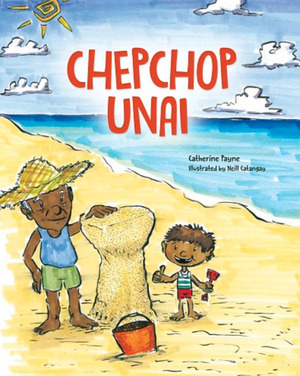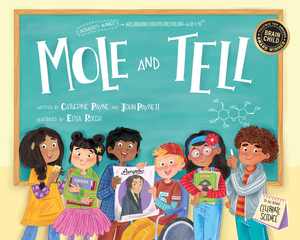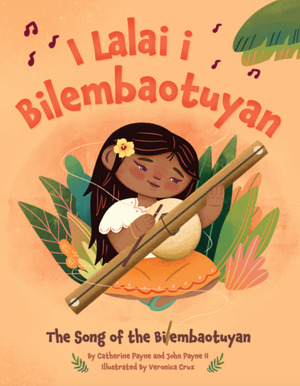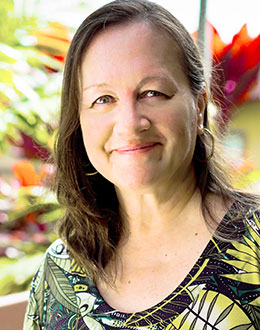Native Hawaiian/Guamanian author Catherine Payne lives by the ancient Chamorro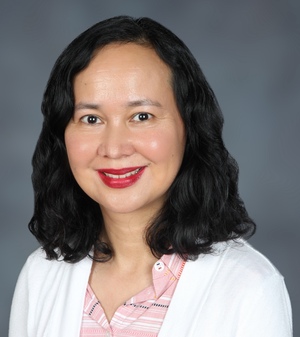 value of inafaʻ maolek, or making things right. An important aspect of inafaʻ maolek is that the whole community, not just the nuclear family, is responsible for raising healthy, happy children. Picture books, says the author of five books for kids, can be key to opening conversations between children and grown-ups.
value of inafaʻ maolek, or making things right. An important aspect of inafaʻ maolek is that the whole community, not just the nuclear family, is responsible for raising healthy, happy children. Picture books, says the author of five books for kids, can be key to opening conversations between children and grown-ups.
We certainly agree. Welcome, Cathy, to our talk story!
Aloha and håfa adai! Before we begin, please allow me to explain a little about our language.
The CHamoru Language Commission on Guam decided to use the CHamoru spelling for its orthography, but some people still use the Chamorro spelling. The Chamorro people in the Commonwealth of the Northern Mariana Islands still use the Chamorro spelling. To avoid the debate, I used CHamoru/Chamorro in my answers.
Since I’m mixed race but born and raised on Guam, I prefer to be called Guamanian.
Mahalo for that, Cathy. For those who haven’t met you yet, please tell us a little about yourself.
My mother is from Oahu, and my father is from Guam. I was born and raised on Guam where I ate CHamoru/Chamorro food as much as I could! I graduated from the Academy of Our Lady of Guam. My biggest supporter was my maternal grandfather, who was from Oahu. He passed away when I was in high school, but his support still means a lot to me.
Why did you become author? Have you always wanted to be an author?
I’ve loved writing since I could grip a pencil, but I didn’t try children’s literature until about a decade ago. There are so many kinds of writing that it took me a while to figure out that I should consider children’s literature.
What do you enjoy most about writing, especially for kids? What are some of your greatest challenges?
I love reading my books to children and seeing their reactions! My greatest challenge is finding time to grow as a writer. I’m busy as an English instructor and tutor, but I read craft books and watch craft webinars when I can.
What is your writing process like?
I spend a lot of time thinking and talking about story ideas before drafting. I usually revise drafts countless times.
Three of your books are co-authored by your brother, John Payne. What is it like to work with a family member? What strengths do each of you bring to a project?
I like working with my brother to develop stories. He brings his imagination; I bring my analysis. While he comes up with new ideas, I follow industry standards for plotting.
Please tell us about Chepchop Unai. What inspired you to write that story? Who inspired your main characters? What do you like best about them?
I’ve always wanted to write about Guam because it’s my home. Chepchop Unai is written mostly in English, but it has a sprinkling of CHamoru/Chamorro words. It reflects the way I speak. My first language is English, but I use CHamoru/Chamorro words to express certain ideas. My family inspired my main characters because the story depicts a close relationship between a child and his grandparents. I like showing how grandparents are important in children’s lives.
Mole and Tell is your STEM picture book. Itʻs quite different from your other titles. What was the journey like to write that book? What was your favorite part of writing your books? What was most challenging?
Yes, I ventured outside my comfort zone to write a science book like Mole and Tell. One of my favorite parts of the process was having incidental diversity. It features a Native Hawaiian girl named Leilani! The most challenging part was making scientific concepts understandable and engaging at the same time.
Youʻve also written two board books for younger kids, Ten Little Surfers in Hawaiʻi and These Little Kittens in Hawaiʻi. What inspired you to write those books? How did those books come about? What did you enjoy about writing them?
I’ve always wanted to write about Hawaiʻi because I love visiting there. After writing and revising stories set in Hawaiʻi, I sent them to a publisher. Luckily, they’ve done well.
Without giving too much away, what is I Lalai i Bilembaotuyuan about? Can you talk about your main character? What characteristics do you love about her?
I Lalai i Bilembaotuyan is a picture book about a girl learning how to play the bilembaotuyan, a CHamoru musical instrument, from her grandfather. At the same time, she learns how to cope with anticipatory grief.
Through her curiosity, Lalai finds her passion for playing the bilembaotuyan. I love Lalai’s curiosity and her desire to learn. It’s important for children to explore and try things to find their interests and passions.
Do you have any experiences as a Guamanian writer that you might share with our readers? What would you like to see change in the industry regarding the acceptance of BIPOC creators?
The U.S. book industry focuses on Western story structures like Freytag’s Pyramid, but following that model doesn’t come naturally to me. I hope that the industry becomes more open to alternative narrative structures.
What beliefs do you think your work challenging?
I’ve met people who didn’t think it was possible to have a literary career while living on Guam. Thanks to the internet, I’ve joined online writing communities, taken classes, and collaborated with publishers beyond Guam’s shores. Living on Guam hasn’t hindered me.
What are your hopes and dreams for the year and beyond in terms of your publishing career and what you would like to see published in the future?
I’m having fun writing more science picture books, and I’m also learning how to write chapter books and middle-grade novels.
What advice would you give an aspiring writer?
Please don’t let your location limit you. You can thrive even if you live on an island in Typhoon Alley like Guam. Sure, storms make life harder, but they run out of rain.
As you know, we always end our interviews with niele questions … Is there a fun fact youʻd like to share about yourself with young readers?
When I was a little girl, I wanted a name like Leilani, so I gave a character in Mole and Tell that name.
What kinds of books do you enjoy reading? Any favorites?
I enjoy reading short stories with plot twists like Ray Bradbury’s “A Sound of Thunder.”
Who is your hero?
I admire Queen Liliʻuokalani’s leadership and artistry. She is a good role model for females.
She’s my hero, too. What advice would you give your younger self?
It’s ok to not know what you want to be when you grow up. I eventually found my purpose in life after taking paths with dead ends.
Good advice, for sure. Mahalo, Cathy, for talking story with us! To learn more about Cathy, visit her on Instagram and listen to her watch her interview with Read with Rosa on YouTube.
Images courtesy of Catherine Payne.



